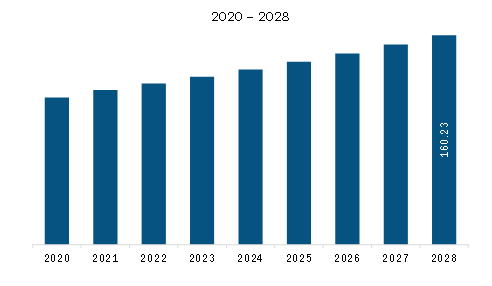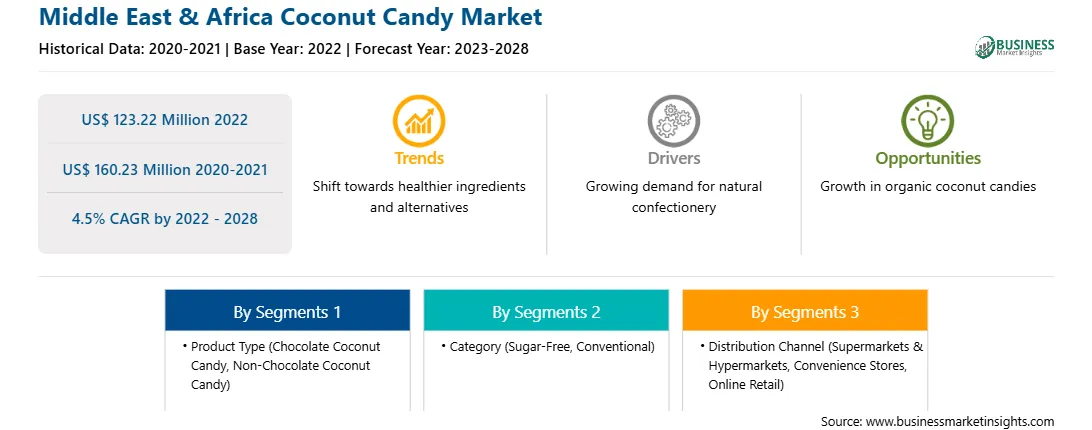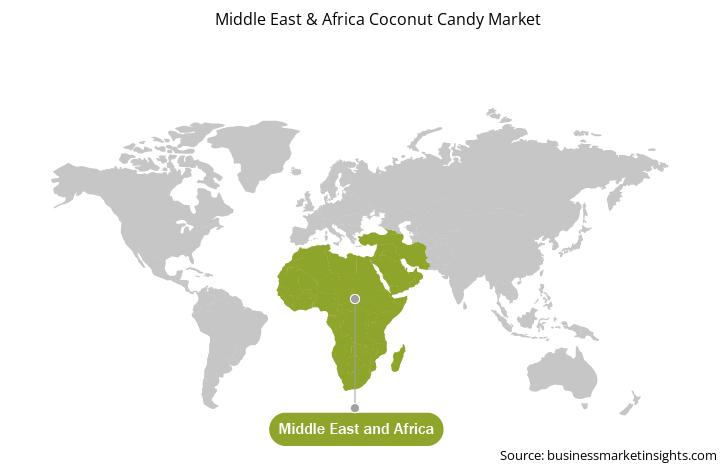The coconut candy market in Middle East & Africa is expected to grow from US$ 123.22 million in 2022 to US$ 160.23 million by 2028. It is estimated to grow at a CAGR of 4.5% from 2022 to 2028.
Surging Demand for Sugar-Free and Organic Coconut Candies
People, nowadays, are becoming more concerned about the health impacts of consuming sugar-dense food and beverages. As a result, they are shifting to sugar-free or low-sugar alternatives to stay fit. This trend is gaining traction in the confectionery industry, which is significantly driving the demand for sugar-free coconut candies. Many companies also offer certified organic coconut candies that are gaining immense popularity among consumers. Organic ingredients are perceived to be healthier than conventional ones as they are obtained from farming practices that are free of pesticides, genetically modified organisms, and chemical additives. Moreover, these ingredients are grown following stringent agricultural practices that avoid the use of growth hormones and synthetic additives. Thus, the growing inclination toward sugar-free and organic coconut candies is expected to provide lucrative growth opportunities to the MEA coconut candy market in the coming years.
Market Overview
South Africa, Saudi Arabia, the UAE, and the Rest of Middle East & Africa are the key contributors to the coconut candy market in the Middle East & Africa. With a recovery in economic growth and appreciation of the local currency following the recession and severe depreciation in 2016, the confectionery industry witnessed significant growth in the region. Additionally, consumers’ tastes and their inclination toward chocolates and sweets are the never-ending reason behind the growth of the confectionery market in the region. As consumers across the region are becoming more sophisticated and health conscious, they are increasingly searching for naturally flavored confectioneries that are differentiated from standard products. Growing awareness regarding the benefits of consuming coconut products has been augmenting the market growth. Coconut flesh is highly nutritious and provides fibers and vitamins—E, C, B1, B3, B5, and B6—as well as minerals such as iron, sodium, calcium, magnesium, selenium, and phosphorous. These factors have resulted in a surge in demand for coconut-based confectionery products and are further expected to stroke the growth of the Middle East & Africa coconut candy market in the future.
Middle East & Africa Coconut Candy Market Revenue and Forecast to 2028 (US$ Million)

Strategic insights for the Middle East & Africa Coconut Candy provides data-driven analysis of the industry landscape, including current trends, key players, and regional nuances. These insights offer actionable recommendations, enabling readers to differentiate themselves from competitors by identifying untapped segments or developing unique value propositions. Leveraging data analytics, these insights help industry players anticipate the market shifts, whether investors, manufacturers, or other stakeholders. A future-oriented perspective is essential, helping stakeholders anticipate market shifts and position themselves for long-term success in this dynamic region. Ultimately, effective strategic insights empower readers to make informed decisions that drive profitability and achieve their business objectives within the market.

| Report Attribute | Details |
|---|---|
| Market size in 2022 | US$ 123.22 Million |
| Market Size by 2028 | US$ 160.23 Million |
| Global CAGR (2022 - 2028) | 4.5% |
| Historical Data | 2020-2021 |
| Forecast period | 2023-2028 |
| Segments Covered |
By Product Type
|
| Regions and Countries Covered | Middle East and Africa
|
| Market leaders and key company profiles |
The geographic scope of the Middle East & Africa Coconut Candy refers to the specific areas in which a business operates and competes. Understanding local distinctions, such as diverse consumer preferences (e.g., demand for specific plug types or battery backup durations), varying economic conditions, and regulatory environments, is crucial for tailoring strategies to specific markets. Businesses can expand their reach by identifying underserved areas or adapting their offerings to meet local demands. A clear market focus allows for more effective resource allocation, targeted marketing campaigns, and better positioning against local competitors, ultimately driving growth in those targeted areas.

Middle East & Africa Coconut Candy Market Segmentation
The Middle East & Africa coconut candy market is segmented into product type, category, distribution channel, and country.
Based on product type, the market is bifurcated into chocolate coconut candy and non-chocolate coconut candy. The chocolate coconut candy segment registered the larger market share in 2022.
Based on category, the market is bifurcated into sugar-free and conventional. The conventional segment held a larger market share in 2022.
Based on distribution channel, the market is segmented into supermarkets & hypermarkets, convenience stores, online retail, and others. The supermarkets & hypermarkets segment held the largest market share in 2022.
Based on country, the market is segmented into South Africa, Saudi Arabia, the UAE, and the Rest of Middle East & Africa. The Rest of Middle East & Africa dominated the market share in 2022.
Alfred Ritter GmbH & Co. KG; Chocoladefabriken Lindt and Spruengli AG; Ferrero International S.A.; Godiva; Mars Incorporated; The Hershey Company; Unreal Brands Inc.; and Weetabix Food Co. are the leading companies operating in the coconut candy market in the Middle East & Africa region.
The Middle East & Africa Coconut Candy Market is valued at US$ 123.22 Million in 2022, it is projected to reach US$ 160.23 Million by 2028.
As per our report Middle East & Africa Coconut Candy Market, the market size is valued at US$ 123.22 Million in 2022, projecting it to reach US$ 160.23 Million by 2028. This translates to a CAGR of approximately 4.5% during the forecast period.
The Middle East & Africa Coconut Candy Market report typically cover these key segments-
The historic period, base year, and forecast period can vary slightly depending on the specific market research report. However, for the Middle East & Africa Coconut Candy Market report:
The Middle East & Africa Coconut Candy Market is populated by several key players, each contributing to its growth and innovation. Some of the major players include:
The Middle East & Africa Coconut Candy Market report is valuable for diverse stakeholders, including:
Essentially, anyone involved in or considering involvement in the Middle East & Africa Coconut Candy Market value chain can benefit from the information contained in a comprehensive market report.